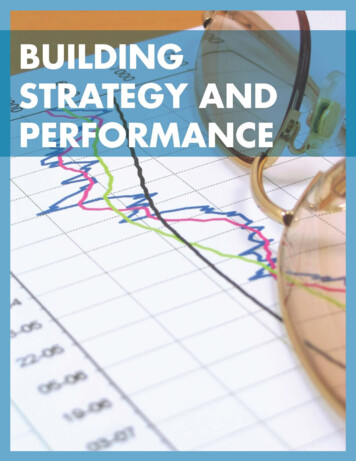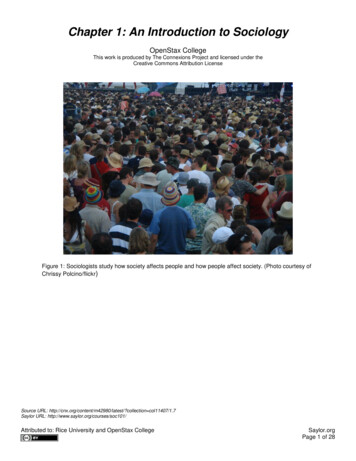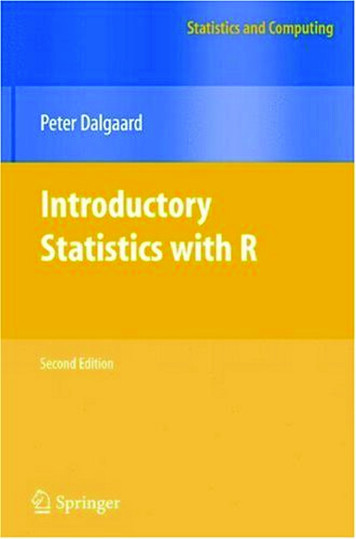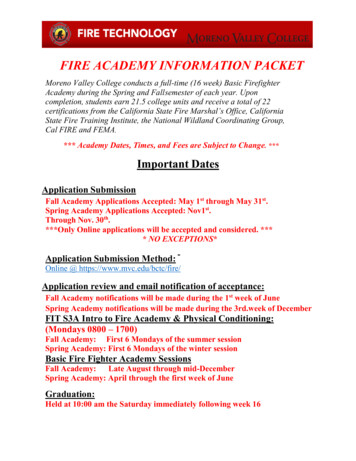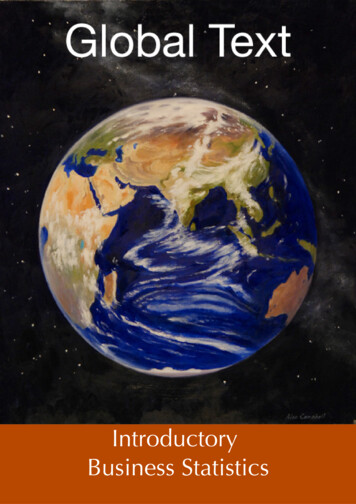
Transcription
IntroductoryBusiness Statistics
IntroductoryBusiness StatisticsThomas K. TiemannCopyright 2010 by Thomas K. TiemannFor any questions about this text, please email: drexel@uga.eduEditor-In-Chief: Thomas K. TiemannAssociate Editor: Marisa DrexelEditorial Assistants: Jaclyn Sharman, LaKwanzaa WaltonThe Global Text Project is funded by the Jacobs Foundation, Zurich, Switzerland.This book is licensed under a Creative Commons Attribution 3.0 License
This book is licensed under a Creative Commons Attribution 3.0 LicenseTable of ContentsWhat is statistics? . 51. Descriptive statistics and frequency distributions. 10Descriptive statistics. 122. The normal and t-distributions. 18Normal things. 18The t-distribution. 223. Making estimates.26Estimating the population mean. 26Estimating the population proportion. 27Estimating population variance. 294. Hypothesis testing . 32The strategy of hypothesis testing. 335. The t-test.41The t-distribution. 416. F-test and one-way anova.52Analysis of variance (ANOVA). 557. Some non-parametric tests.59Do these populations have the same location? The Mann-Whitney U test. 60Testing with matched pairs: the Wilcoxon signed ranks test. 63Are these two variables related? Spearman's rank correlation. 668. Regression basics.70What is regression? . 70Correlation and covariance. 79Covariance, correlation, and regression. 81Introductory Business Statistics3A Global Text
This book is licensed under a Creative Commons Attribution 3.0 LicenseAbout the authorAuthor, Thomas K. TiemannThomas K. Tiemann is Jefferson Pilot Professor of Economics at Elon University in North Carolina, USA. Heearned an AB in Economics at Dartmouth College and a PhD at Vanderbilt University. He has been teaching basicbusiness and economics statistics for over 30 years, and tries to take an intuitive approach, rather than amathematical approach, when teaching statistics. He started working on this book 15 years ago, but got sidetrackedby administrative duties. He hopes that this intuitive approach helps students around the world better understandthe mysteries of statistics.A note from the author: Why did I write this text?I have been teaching introductory statistics to undergraduate economics and business students for almost 30years. When I took the course as an undergraduate, before computers were widely available to students, we had lotsof homework, and learned how to do the arithmetic needed to get the mathematical answer. When I got to graduateschool, I found out that I did not have any idea of how statistics worked, or what test to use in what situation. Thefirst few times I taught the course, I stressed learning what test to use in what situation and what the arithmeticanswer meant.As computers became more and more available, students would do statistical studies that would have takenmonths to perform before, and it became even more important that students understand some of the basic ideasbehind statistics, especially the sampling distribution, so I shifted my courses toward an intuitive understanding ofsampling distributions and their place in hypothesis testing. That is what is presented here—my attempt to helpstudents understand how statistics works, not just how to “get the right number”.Introductory Business Statistics4A Global Text
This book is licensed under a Creative Commons Attribution 3.0 LicenseWhat is statistics?There are two common definitions of statistics. The first is "turning data into information", the second is"making inferences about populations from samples". These two definitions are quite different, but between themthey capture most of what you will learn in most introductory statistics courses. The first, "turning data intoinformation," is a good definition of descriptive statistics—the topic of the first part of this, and most, introductorytexts. The second, "making inferences about populations from samples", is a good definition of inferential statistics—the topic of the latter part of this, and most, introductory texts.To reach an understanding of the second definition an understanding of the first definition is needed; that iswhy we will study descriptive statistics before inferential statistics. To reach an understanding of how to turn datainto information, an understanding of some terms and concepts is needed. This first chapter provides anexplanation of the terms and concepts you will need before you can do anything statistical.Before starting in on statistics, I want to introduce you to the two young managers who will be using statistics tosolve problems throughout this book. Ann Howard and Kevin Schmidt just graduated from college last year, andwere hired as "Assistants to the General Manager" at Foothill Mills, a small manufacturer of socks, stockings, andpantyhose. Since Foothill is a small firm, Ann and Kevin get a wide variety of assignments. Their boss, JohnMcGrath, knows a lot about knitting hosiery, but is from the old school of management, and doesn't know muchabout using statistics to solve business problems. We will see Ann or Kevin, or both, in every chapter. By the end ofthe book, they may solve enough problems, and use enough statistics, to earn promotions.Data and information; samples and populationsThough we tend to use data and information interchangeably in normal conversation, we need to think of themas different things when we are thinking about statistics. Data is the raw numbers before we do anything with them.Information is the product of arranging and summarizing those numbers. A listing of the score everyone earned onthe first statistics test I gave last semester is data. If you summarize that data by computing the mean (the averagescore), or by producing a table that shows how many students earned A's, how many B's, etc. you have turned thedata into information.Imagine that one of Foothill Mill's high profile, but small sales, products is "Easy Bounce", a cushioned sock thathelps keep basketball players from bruising their feet as they come down from jumping. John McGrath gave Annand Kevin the task of finding new markets for Easy Bounce socks. Ann and Kevin have decided that a goodextension of this market is college volleyball players. Before they start, they want to learn about what size sockscollege volleyball players wear. First they need to gather some data, maybe by calling some equipment managersfrom nearby colleges to ask how many of what size volleyball socks were used last season. Then they will want toturn that data into information by arranging and summarizing their data, possibly even comparing the sizes ofvolleyball socks used at nearby colleges to the sizes of socks sold to basketball players.Some definitions and important conceptsIt may seem obvious, but a population is all of the members of a certain group. A sample is some of the membersof the population. The same group of individuals may be a population in one context and a sample in another. Thewomen in your stat class are the population of "women enrolled in this statistics class", and they are also a sampleof "all students enrolled in this statistics class". It is important to be aware of what sample you are using to make aninference about what population.Introductory Business Statistics5A Global Text
What is statistics?How exact is statistics? Upon close inspection, you will find that statistics is not all that exact; sometimes I havetold my classes that statistics is "knowing when its close enough to call it equal". When making estimations, you willfind that you are almost never exactly right. If you make the estimations using the correct method however, you willseldom be far from wrong. The same idea goes for hypothesis testing. You can never be sure that you've made thecorrect judgement, but if you conduct the hypothesis test with the correct method, you can be sure that the chanceyou've made the wrong judgement is small.A term that needs to be defined is probability. Probability is a measure of the chance that something willoccur. In statistics, when an inference is made, it is made with some probability that it is wrong (or some confidencethat it is right). Think about repeating some action, like using a certain procedure to infer the mean of a population,over and over and over. Inevitably, sometimes the procedure will give a faulty estimate, sometimes you will bewrong. The probability that the procedure gives the wrong answer is simply the proportion of the times that theestimate is wrong. The confidence is simply the proportion of times that the answer is right. The probability ofsomething happening is expressed as the proportion of the time that it can be expected to happen. Proportions arewritten as decimal fractions, and so are probabilities. If the probability that Foothill Hosiery's best salesperson willmake the sale is .75, three-quarters of the time the sale is made.Why bother with stat?Reflect on what you have just read. What you are going to learn to do by learning statistics is to learn the rightway to make educated guesses. For most students, statistics is not a favorite course. Its viewed as hard, or cosmic,or just plain confusing. By now, you should be thinking: "I could just skip stat, and avoid making inferences aboutwhat populations are like by always collecting data on the whole population and knowing for sure what thepopulation is like." Well, many things come back to money, and its money that makes you take stat. Collecting dataon a whole population is usually very expensive, and often almost impossible. If you can make a good, educatedinference about a population from data collected from a small portion of that population, you will be able to saveyourself, and your employer, a lot of time and money. You will also be able to make inferences about populationsfor which collecting data on the whole population is virtually impossible. Learning statistics now will allow you tosave resources later and if the resources saved later are greater than the cost of learning statistics now, it will beworthwhile to learn statistics. It is my hope that the approach followed in this text will reduce the initial cost oflearning statistics. If you have already had finance, you'll understand it this way—this approach to learningstatistics will increase the net present value of investing in learning statistics by decreasing the initial cost.Imagine how long it would take and how expensive it would be if Ann and Kevin decided that they had to findout what size sock every college volleyball player wore in order to see if volleyball players wore the same size socksas basketball players. By knowing how samples are related to populations, Ann and Kevin can quickly andinexpensively get a good idea of what size socks volleyball players wear, saving Foothill a lot of money and keepingJohn McGrath happy.There are two basic types of inferences that can be made. The first is to estimate something about thepopulation, usually its mean. The second is to see if the population has certain characteristics, for example youmight want to infer if a population has a mean greater than 5.6. This second type of inference, hypothesis testing, iswhat we will concentrate on. If you understand hypothesis testing, estimation is easy. There are many applications,6
This book is licensed under a Creative Commons Attribution 3.0 Licenseespecially in more advanced statistics, in which the difference between estimation and hypothesis testing seemsblurred.EstimationEstimation is one of the basic inferential statistics techniques. The idea is simple; collect data from a sample andprocess it in some way that yields a good inference of something about the population. There are two types ofestimates: point estimates and interval estimates. To make a point estimate, you simply find the single number thatyou think is your best guess of the characteristic of the population. As you can imagine, you will seldom be exactlycorrect, but if you make your estimate correctly, you will seldom be very far wrong. How to correctly make theseestimates is an important part of statistics.To make an interval estimate, you define an interval within which you believe the population characteristic lies.Generally, the wider the interval, the more confident you are that it contains the population characteristic. At oneextreme, you have complete confidence that the mean of a population lies between - and but that informationhas little value. At the other extreme, though you can feel comfortable that the population mean has a value close tothat guessed by a correctly conducted point estimate, you have almost no confidence ("zero plus" to statisticians)that the population mean is exactly equal to the estimate. There is a trade-off between width of the interval, andconfidence that it contains the population mean. How to find a narrow range with an acceptable level of confidenceis another skill learned when learning statistics.Hypothesis testingThe other type of inference is hypothesis testing. Though hypothesis testing and interval estimation use similarmathematics, they make quite different inferences about the population. Estimation makes no prior statementabout the population; it is designed to make an educated guess about a population that you know nothing about.Hypothesis testing tests to see if the population has a certain characteristic—say a certain mean. This works byusing statisticians' knowledge of how samples taken from populations with certain characteristics are likely to lookto see if the sample you have is likely to have come from such a population.A simple example is probably the best way to get to this. Statisticians know that if the means of a large numberof samples of the same size taken from the same population are averaged together, the mean of those sample meansequals the mean of the original population, and that most of those sample means will be fairly close to thepopulation mean. If you have a sample that you suspect comes from a certain population, you can test thehypothesis that the population mean equals some number, m, by seeing if your sample has a mean close to m ornot. If your sample has a mean close to m, you can comfortably say that your sample is likely to be one of thesamples from a population with a mean of m.SamplingIt is important to recognize that there is another cost to using statistics, even after you have learned statistics. Aswe said before, you are never sure that your inferences are correct. The more precise you want your inference to be,either the larger the sample you will have to collect (and the more time and money you'll have to spend oncollecting it), or the greater the chance you must take that you'll make a mistake. Basically, if your sample is a goodrepresentation of the whole population—if it contains members from across the range of the population inproportions similar to that in the population—the inferences made will be good. If you manage to pick a sample thatis not a good representation of the population, your inferences are likely to be wrong. By choosing samplesIntroductory Business Statistics7A Global Text
What is statistics?carefully, you can increase the chance of a sample which is representative of the population, and increase thechance of an accurate inference.The intuition behind this is easy. Imagine that you want to infer the mean of a population. The way to do this isto choose a sample, find the mean of that sample, and use that sample mean as your inference of the populationmean. If your sample happened to include all, or almost all, observations with values that are at the high end ofthose in the population, your sample mean will overestimate the population mean. If your sample includes roughlyequal numbers of observations with "high" and "low" and "middle" values, the mean of the sample will be close tothe population mean, and the sample mean will provide a good inference of the population mean. If your sampleincludes mostly observations from the middle of the population, you will also get a good inference. Note that thesample mean will seldom be exactly equal to the population mean, however, because most samples will have arough balance between high and low and middle values, the sample mean will usually be close to the truepopulation mean. The key to good sampling is to avoid choosing the members of your sample in a manner thattends to choose too many "high" or too many "low" observations.There are three basic ways to accomplish this goal. You can choose your sample randomly, you can choose astratified sample, or you can choose a cluster sample. While there is no way to insure that a single sample will berepresentative, following the discipline of random, stratified, or cluster sampling greatly reduces the probability ofchoosing an unrepresentative sample.The sampling distributionThe thing that makes statistics work is that statisticians have discovered how samples are related to populations.This means that statisticians (and, by the end of the course, you) know that if all of the possible samples from apopulation are taken and something (generically called a “statistic”) is computed for each sample, something isknown about how the new population of statistics computed from each sample is related to the original population.For example, if all of the samples of a given size are taken from a population, the mean of each sample is computed,and then the mean of those sample means is found, statisticians know that the mean of the sample means is equalto the mean of the original population.There are many possible sampling distributions. Many different statistics can be computed from the samples,and each different original population will generate a different set of samples. The amazing thing, and the thing thatmakes it possible to make inferences about populations from samples, is that there are a few statistics which allhave about the same sampling distribution when computed from the samples from many different populations.You are probably still a little confused about what a sampling distribution is. It will be discussed more in thechapter on the Normal and t-distributions. An example here will help. Imagine that you have a population —thesock sizes of all of the volleyball players in the South Atlantic Conference. You take a sample of a certain size, saysix, and find the mean of that sample. Then take another sample of six sock sizes, and find the mean of that sample.Keep taking different samples until you've found the mean of all of the possible samples of six. You will havegenerated a new population, the population of sample means. This population is the sampling distribution. Becausestatisticians often can find what proportion of members of this new population will take on certain values if theyknow certain things about the original population, we will be able to make certain inferences about the originalpopulation from a single sample.8
This book is licensed under a Creative Commons Attribution 3.0 LicenseUnivariate and multivariate statistics statistics and the idea of an observation.A population may include just one thing about every member of a group, or it may include two or more thingsabout every member. In either case there will be one observation for each group member. Univariate statistics areconcerned with making inferences about one variable populations, like "what is the mean shoe size of businessstudents?" Multivariate statistics is concerned with making inferences about the way that two or more variables areconnected in the population like, "do students with high grade point averages usually have big feet?" What'simportant about multivariate statistics is that it allows you to make better predictions. If you had to predict the shoesize of a business student and you had found out that students with high grade point averages usually have big feet,knowing the student's grade point average might help. Multivariate statistics are powerful and find applications ineconomics, finance, and cost accounting.Ann Howard and Kevin Schmidt might use multivariate statistics if Mr McGrath asked them to study the effectsof radio advertising on sock sales. They could collect a multivariate sample by collecting two variables from each ofa number of cities—recent changes in sales and the amount spent on radio ads. By using multivariate techniquesyou will learn in later chapters, Ann and Kevin can see if more radio advertising means more sock sales.ConclusionAs you can see, there is a lot of ground to cover by the end of this course. There are a few ideas that tie most ofwhat you learn together: populations and samples, the difference between data and information, and mostimportant, sampling distributions. We'll start out with the easiest part, descriptive statistics, turning data intoinformation. Your professor will probably skip some chapters, or do a chapter toward the end of the book beforeone that's earlier in the book. As long as you cover the chapters “Descriptive Statistics and frequency distributions” ,“The normal and the t-distributions”, “Making estimates” and that is alright.You should learn more than just statistics by the time the semester is over. Statistics is fairly difficult, largelybecause understanding what is going on requires that you learn to stand back and think about things; you cannotmemorize it all, you have to figure out much of it. This will help you learn to use statistics, not just learn statisticsfor its own sake.You will do much better if you attend class regularly and if you read each chapter at least three times. First, theday before you are going to discuss a topic in class, read the chapter carefully, but do not worry if you understandeverything. Second, soon after a topic has been covered in class, read the chapter again, this time going slowly,making sure you can see what is going on. Finally, read it again before the exam. Though this is a great statisticsbook, the stuff is hard, and no one understands statistics the first time.Introductory Business Statistics9A Global Text
This book is licensed under a Creative Commons Attribution 3.0 License1. Descriptive statistics andfrequency distributionsThis chapter is about describing populations and samples, a subject known as descriptive statistics. This will allmake more sense if you keep in mind that the information you want to produce is a description of the population orsample as a whole, not a description of one member of the population. The first topic in this chapter is a discussionof "distributions", essentially pictures of populations (or samples). Second will be the discussion of descriptivestatistics. The topics are arranged in this order because the descriptive statistics can be thought of as ways todescribe the picture of a population, the distribution.DistributionsThe first step in turning data into information is to create a distribution. The most primitive way to present adistribution is to simply list, in one column, each value that occurs in the population and, in the next column, thenumber of times it occurs. It is customary to list the values from lowest to highest. This is simple listing is called a"frequency distribution". A more elegant way to turn data into information is to draw a graph of the distribution.Customarily, the values that occur are put along the horizontal axis and the frequency of the value is on the verticalaxis.Ann Howard called the equipment manager at two nearby colleges and found out the following data on socksizes used by volleyball players. At Piedmont State last year, 14 pairs of size 7 socks, 18 pairs of size 8, 15 pairs ofsize 9, and 6 pairs of size 10 socks were used. At Graham College, the volleyball team used 3 pairs of size 6, 10 pairsof size 7, 15 pairs of size 8, 5 pairs of size 9, and 11 pairs of size 10. Ann arranged her data into a distribution andthen drew a graph called a Histogram:Exhibit 1: Frequency graph of sock sizesIntroductory Business Statistics10A Global Text
1. Descriptive statistics and frequency distributionsAnn could have created a relative frequency distribution as well as a frequency distribution. The difference isthat instead of listing how many times each value occurred, Ann would list what proportion of her sample was madeup of socks of each size:Exhibit 2: Relative frequency graph of sock sizesNotice that Ann has drawn the graphs differently. In the first graph, she has used bars for each value, while onthe second, she has drawn a point for the relative frequency of each size, and the "connected the dots". While bothmethods are correct, when you have a values that are continuous, you will want to do something more like the"connect the dots" graph. Sock sizes are discrete, they only take on a limited number of values. Other things havecontinuous values, they can take on an infinite number of values, though we are often in the habit of roundingthem off. An example is how much students weigh. While we usually give our weight in whole pounds in the US ("Iweigh 156 pounds."), few have a weight that is exactly so many pounds. When you say "I weigh 156", you actuallymean that you weigh between 155 1/2 and 156 1/2 pounds. We are heading toward a graph of a distribution of acontinuous variable where the relative frequency of any exact value is very small, but the relative frequency ofobservations between two values is measurable. What we want to do is to get used to the idea that the total areaunder a "connect the dots" relative frequency graph, from the lowest to the highest possible value is one. Then thepart of the area under the graph between two values is the relative frequency of observations with values within thatrange. The height of the line above any particular value has lost any direct meaning, because it is now the areaunder the line between two values that is the relative frequency of an observation between those two valuesoccurring.You can get some idea of how this works if you go back to the bar graph of the distribution of sock sizes, butdraw it with relative frequency on the vertical axis. If you arbitrarily decide that each bar has a width of one, thenthe area "under the curve" between 7.5 and 8.5 is simply the height times the width of the bar for sock size 8: 0.3510x 1. If you wanted to find the relative frequency of sock sizes between 6.5 and 8.5, you could simply add together thearea of the bar for size 7 (that's between 6.5 and 7.5) and the bar for size 8 (between 7.5 and 8.5).11
This book is licensed under a Creative Commons Attribution 3.0 LicenseDescriptive statisticsNow that you see how a distribution is created, you are ready to learn how to describe one. There are two mainthings that need to be described about a distribution: its location and its shape. Generally, it is best to give a singlemeasure as the description of the location and a single measure as the description of the shape.MeanTo describe the location of a distribution, statisticians use a "typical" value from the distribution. There are anumber of different ways to find the typical value, but by far the most used is the "arithmetic mean", usually simplycalled the "mean". You already know how to find the arithmetic mean, you are just used to calling it the "average".Statisticians use average more gen
Thomas K. Tiemann is Jefferson Pilot Professor of Economics at Elon University in North Carolina, USA. He earned an AB in Economics at Dartmouth College and a PhD at Vanderbilt University. He has been teaching basic business and economics statistics for over 30 year

